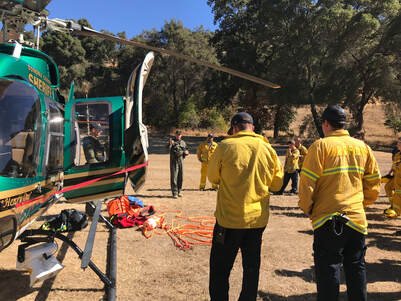A Training Mantra…
A good training motto for continuous training is:
“Let no ones’ ghost return and say their training let them down”
Regular and continued training is an essential element of fire service. The Northshore Fire District is an ALL Risk Agency meaning it responds to Structure Fires, Wildland Fires, Debris Fires, Vehicle Accidents, Medical Aids, and Public Assistance. The Northshore Fire District is a large district covering 357 square miles with 47 miles of Highway 20 stretched along the North Shore of Clear Lake from the Mendocino County line to the Colusa County line serving the communities of Blue Lakes, Bachelor Valley, Witter Springs, Upper Lake, Nice, Lucerne, Glenhaven, Clearlake Oaks and Spring Valley.
Training for new paid Firefighter-I/EMT or Firefighter-I/Paramedic begins on the first day of employment. They are provided with a “New Paid Firefighter Task Book”, which must be completed within 30 days. The tasks require the firefighter to demonstrate that they understand and are able to perform the skills of a firefighter and requires sign off by the assigned trainer. All new paid firefighters hired by the District have already attained at a minimum level Firefighter-I status and therefore has already received the basic training and knowledge to perform many of the tasks outlined in the task book. The purpose of the task book is to familiarize the firefighter with the Northshore Fire District’s operations, policies, and procedures. In addition, they will become familiar with the vast area covered and the full range of responses required of an all-risk agency.
The areas covered by the task book are Station Orientations and Organizational structure, District policies, procedures, and protocols; General Safety (including proper use of personal protective gear); Vehicle Orientation of all district equipment and where they are assigned; Radio communications; Hospital locations and protocols; EMS usage of medical equipment on the ambulances; Ladder types and usage; Hose types, sizes and their proper use; Hydrant - proper operations and safety procedures in securing lines; Ventilation theory and practice; Vehicle Accidents - potential fire hazard identifications, traffic control procedures, and use of basic tools utilized in auto extrication; Wildland Fighting knowledge - general hazards, safety issues, use of equipment and deployment of wildland fire shelters.
The final task for the New Paid Firefighters will be participating in ride-a-longs at each of the three fully-staffed stations (85- Nice, 80 – Lucerne, and 75 – Clearlake Oaks) to help familiarize them with the area as a third firefighter shift assigned at each of those stations. Once the firefighter has completed all of the tasks outlined in the task book and has demonstrated competency and performance to a Northshore Fire Protection District Training officer, the Fire Chief will review the task book and sign off on its completion and the training of the new firefighter.
Once a firefighter completes their New Paid Firefighter task book, then they will transition to a Training Record Book from that point on. This record book documents the ongoing training of the firefighter in both skilled tasks (including driver training) as well as target solutions training (online educational requirements). Each quarter there are specific training exercises and drills that they will be evaluated on. Anything that you can do now, on the training ground to make themselves more proficient and more complete will pay off on the bigger stage. Continuous training prepares the firefighters to do extreme tasks when they are required by instinct and repetition, so they have regularly scheduled drills that they conduct to maintain this level of preparedness. Some of the drills are focused on making sure they set up and focus on intervention or rescue of fellow fire-fighting personnel.
For instance, at every incident there is established a RIC or RIT (Rapid Intervention Crew or Team) that has a designated area with dedicated equipment in order to “save one of our own”. The primary purpose and duty for one or more RIC's being deployed on the fire ground should be to provide a dedicated and specialized team of fire fighters (a minimum of at least 4 per crew) ready to rescue fire fighters who become lost, trapped, injured, disoriented, have a medical problem, or any other reason for immediate rescue or other assistance. This is also related to the 2 in 2 out rule which requires that when upon a scene such as a structure fire, firefighters do not go into a building until they have adequate staffing to have at least two (2) firefighters go in and (2) two available on the outside in the event those that went in need rescue. Often times this is why an initial crew will begin the attack from the exterior in any way they can, until enough resources arrive that allow them to safely enter the building.
All this preparation at a scene enables them to respond quick to a Mayday call. The firefighters train on “Mayday” drills also, Mayday is an international distress signal in radio communications and signals a life-threatening emergency. For firefighters Mayday skills are used for self-rescue in the event they become trapped while inside a structure fire. Part of the drill requires firefighters while in full structure fire gear (including their breathing apparatus) to learn to communicate their condition and location via a radio in the event they become stranded or incapacitated during an emergency situation. The drill simulates what would be the worst day of a firefighter’s life: getting pinned, trapped, disoriented or otherwise incapacitated while responding to a fire. The repetitive nature of the training establishes muscle memory that hopefully will allow them to work through the stress in an actual situation. The mayday drill requires the firefighter to have continuous updates about his/her condition, location, air supply levels and any additional pertinent information. Each Firefighter has a PASS device (Personal alert safety system) that lets out a loud alarm. Once activated, the noise alerts other firefighters and those sent in for rescue. The RIT/RIC are trained to follow and find that piercing sound and will provide additional rescue resources, most importantly an additional air supply. The training helps the firefighters to feel relief and remain calm, knowing there are people working to rescue them. The more they do it the better off they will be in a real situation.
Another drill that is practiced is the Paxton Drill, it is named after the Paxton Hotel Fire incident that occurred in Chicago, IL on March 16, 1993. This was a four-story single room occupancy hotel where people made their homes on permanent or semi-permanent basis. As several people were trapped in their rooms the arriving engines had to immediately begin throwing ladders to as many windows as possible to get people out of the hotel. Once those rescues were made, they would roll the ladders into new positions. The “Paxton Drill” times a crew to see how fast every ladder on the rig can be deployed to designated window on a building. This might seem a bit monotonous, but it could pay off just like it did for the 100 people who were rescued from the Paxton Hotel. Recently, the team conducted LARRO (Low Angle Rope Rescue Operations) training. This is for angles less than 45 degrees and walks through packaging a rescuer to be lowered and security a patient to a litter basket. These drills help rescuers to recognize different types of rescue environments and hazards, how to properly inspect rope and secure knots and rigging, and how to package fellow rescuers as well as patients for safe removal from the incident and protecting them from further harm.
On 9/24/2019, the Northshore District hosted a training with “Henry One”, the Sonoma County Search and Rescue Helicopter. This happened to be a RED Flag Day for us here in Lake County, CA., so in addition to the Northshore Fire Protection Team and some of our Local CAL-Fire Crews we also had a task-force team in from our neighboring counties, they were on the ready because of our Red-Flag status, so they joined us for the training. Training started at the Lucerne fire station for a briefing with the crews about what would be taking place that day… then off to the LZ (Landing Zone) which was an open field at Ceago Vineyards. Here there was another briefing with cautions about how to approach the aircraft, the dangers that can exist in a landing zone and why it is important to select zones that do not have debris that can be kicked up by the landing craft. The exercise of the day was to practice the long line rescues that take place from time to time and also to understand the when and how “Henry One” can be called for support in our area. The Henry One Team consisting of Sgt. Henri Boustany, Flight Paramedic Nick Fitzpatrick, and pilot Nigel Cooper gave the group an overview of the helicopter, the equipment on board and a show and tell of the rigging and methods they use for search and rescue. Once this was completed they continued several drills of tying off firefighters to a 100’ long line and then lifting them up and taking them to the top of the hills behind the field and setting them down on the mountain where they would simulate getting a patient into a litter basket stretcher or harness and bring them back down to the original landing zone. This was done numerous times to give the firefighters the experience of the long line rescue, until they were all alerted out to a small wildland fire call.
Constant training and education of our firefighters is extremely important. They work hard on their training and take it very seriously. When our firefighters engage in training it has to be at the same level of intensity that a real incident would require. Every position with the Northshore Fire District takes some kind of specialized training and/or certification. For EMT’s and Paramedic, beyond the initial certification there is continuing education hours required every year. Our Northshore Fire Team is dedicated to their training because this is how they stay ready for the calls of the Northshore District.




